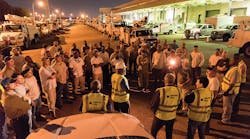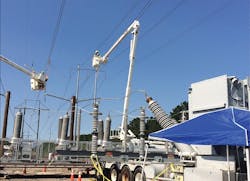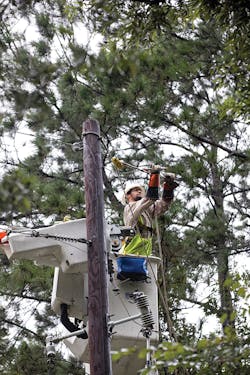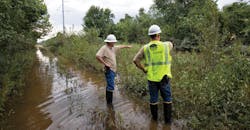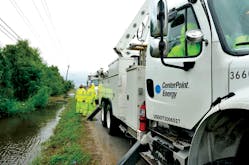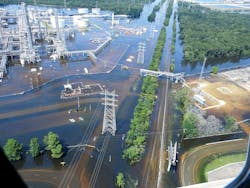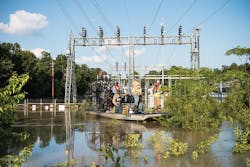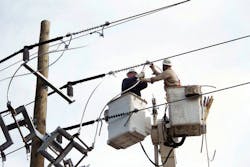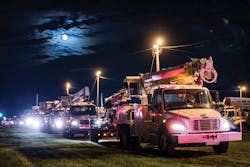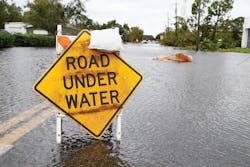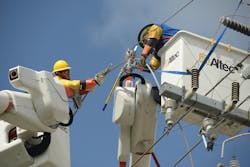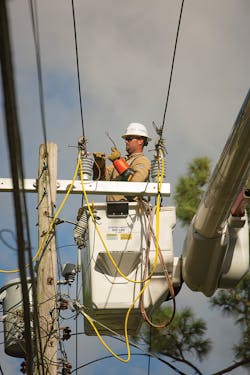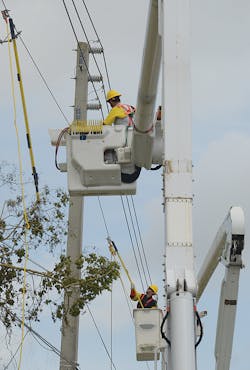When severe storms roar into a utility’s service territory, they often wreak havoc and then dissipate, enabling linemen to begin restoration. Hurricane Harvey, however, unleashed its wrath on electric utilities’ entire systems, inflicting unprecedented destruction.
“Harvey proved to be unlike anything I have experienced in my 28 years in the utility business,” said Frank Shannon, line superintendent for Entergy Texas Inc. in Beaumont, Texas. “This storm impacted our service territory for more than a week as it hit the Texas coast, meandered offshore and finally made landfall again in our service territory.”
Hurricane Harvey flooded Entergy’s service territory and also impacted the systems owned and operated by other utilities, including CenterPoint Energy. Then Mother Nature targeted Florida and Georgia, hurling Hurricane Irma at Duke Energy Florida, Florida Power & Light (FPL) as well as several other companies and cooperatives.
Brandon Hertell, meteorologist and offering manager with The Weather Company and IBM, believes Harvey and Irma will go down in U.S. history as two of the most impactful storms. “It’s hard to prepare for a Cat 5 storm because the powers of nature are so astounding,” he said. “But the Florida and Gulf Coast utilities know how to handle hurricanes, manage a restoration effort and mitigate the impact by hardening their infrastructure. If anyone knows how to do it, it’s these utilities.”
Here are the stories of how these utilities survived the hurricanes, restored power and are rebuilding more resilient and reliable systems.
Entergy: Joining Forces for Restoration
When Harvey made landfall on the night of Friday, Aug. 25, a torrential downpour descended on the western section of Entergy’s service territory for several days. Then the hurricane moved slowly eastward, devastating southeast Texas, including Dayton, Beaumont, Port Arthur, Orange and Vidor.
This record-breaking rainfall and crests of local rivers, lakes and waterways flooded much of Entergy’s service territory. A total of 192,000 Entergy customers lost power over the course of the storm, with 85,000 customer outages at the peak. About 4000 customers sustained such severe flood damage they could not be reconnected.
“We saw firsthand the devastation caused by the flooding, with some areas receiving in excess of 50 inches of rain,” said Frank Shannon, line superintendent for Entergy Texas. “Many employees throughout our company were significantly impacted.”
Over a two-week restoration period, more than 3300 workers from four states joined forces to restore power to all the customers who could safely receive it. For example, Entergy operating companies from Mississippi, Arkansas and Louisiana came to Entergy Texas’ aid along with several line contractors, including T&D Solutions LLC, Willbros Group Inc., Pike Electric Corp., Linetec Services, Bright Star Solutions Inc., Chain Electric Co., Southern Electric Corp. and Highlines Construction. Also, Oncor Electric Delivery Co., Cleco and the Washington-St. Tammany Parish Electric Cooperative Inc. in Louisiana provided much-needed assistance.
“It is always gratifying leading a team of employees who are fully committed to safely restoring power to our customers and helping them, in some small way, to rebuilding what is most important to them,” Shannon said.
Entergy leadership provided oversight to each of the contract partners and was responsible for communicating assignments to the Entergy crews and contractors. “We take great strides to ensure open-air communication and designated boundaries for our crews,” Shannon said. “For example, a particular circuit would only be worked on by one set of contractors to minimize overlap or miscommunication.”
Miles of transmission lines were damaged in the hurricane. While winds and falling trees caused damage to poles, lines and equipment, the transmission lines and substations sustained the most damage. Following the storm, the linemen worked to rebuild the electrical system, replace temporary and damaged equipment with upgraded assets, and add in contingencies and redundancies to ensure reliability.
The flooding impacted 17 of Entergy’s substations, with five sustaining significant damage. Entergy Texas brought in four mobile substations to restore power to customers while linemen made repairs and replaced the damaged equipment.
During the restoration, the most significant challenge was accessing flooded areas. To reach the restoration zones, the linemen used a variety of airboats, amphibious vehicles and high-water vehicles to assess and repair infrastructure. Also, crews systematically patrolled flooded areas and disconnected customers who were impacted until the inspector deemed it safe to restore power.
Because the linemen were working around the floodwater and traveling in boats, Entergy mandated flotation devices and personal protective equipment be worn. “High water and inaccessibility were the primary obstacles we faced,” Shannon said. “And with high water comes snakes, insects and disease. Our company quickly began offering tetanus immunizations and other information to keep our employees safe. As we often do, we improvised and adapted.”
After working 16-hour workdays, the linemen could rest at Entergy Texas’ staging site, which provided food, lodging, fuel, and other necessities for the contractors, crews and support personnel. Because many of the roads were impassible, several of the Entergy Texas employees were not able to return home for about a week. As such, they stayed in Entergy-provided lodging, at the office or at the staging areas.
With the help of the mobile substation and tireless work of the linemen, the crews restored power by Sept. 9 to all customers who could receive it. Entergy Texas worked with the remaining customers who could not receive power to provide them with temporary service as the utility made repairs.
“Harvey was unusual in that it wasn’t just hurricane damage, but it was mainly a historical flooding event,” said Kacee Kirschvink with Entergy Texas. “Harvey made landfall more than once, dumping a record amount of rainfall on southeast Texas. The flooding that came as a result was what made Hurricane Harvey restoration unlike other hurricanes. Our employees and our customers did an outstanding job of working together and making the best of a difficult situation.”
CenterPoint Energy: Gearing Up for a Marathon Restoration
As Hurricane Harvey started making landfall, CenterPoint Energy’s distribution operations center was ready and waiting. Edward Scott, director of operations for distribution power delivery at CenterPoint Energy, monitored the storm from the utility’s distribution evaluation center in Houston, Texas, where he first started seeing the squalls impacting the southwestern parts of the utility’s service territory. When the hurricane began to approach Houston, the team activated its emergency operating plan, stationing first-responder crews within its service territory to respond to escalating trouble, mobilizing logistics, safety and resource management teams, as well.
“Harvey was a moving target for us,” said Scott, who has been with CenterPoint Energy for 18 years. “AEP received the direct hit and impact, and we predicted it would come through as a weak hurricane or a tropical storm. Every plan was based on a snapshot of time based on what we anticipated with the impact. We had to be fluid with our decision making; and when we anticipated escalating impacts, we stood up our full-blown emergency operating plan by mobilizing resources, setting up staging sites and pulling in off-system resources.”
Every year, CenterPoint Energy conducts a storm drill and practices its functional as well as fluid emergency operating plan. Within this strategy, the utility builds in different contingencies and scenarios into its drill days, so the team can make decisions for different types of events. Hurricane Harvey, however, followed its own plan. “It was completely different than anything we have ever seen,” Scott said. “If you look at 2008 with Hurricane Ike, it came through our territory, and, the next day, the sun was out and we could restore service. For this storm, we knew that it was going to be a marathon and not a sprint, so we prepared ourselves for that.”
Whenever a storm approaches, CenterPoint Energy tries to restore power as quickly and safely as possible, and proactively respond to the emergency, according to Scott. “We get our eyes on damage first, and then we isolate down to restore any customers that can have service,” he said.
CenterPoint Energy mobilized its assessment teams, which used drones in inaccessible areas to proactively identify what needed to be restored. Next, the utility was able to isolate known faults through its advanced distribution management system and intelligent grid technology. “We used drones during this event more than we ever have,” Scott noted. “Due to the inaccessibility of the structures, they really worked for us. We also had helicopters fly over the transmission lines to observe the infrastructure and damage, as well.”
Through its investigation, the utility discovered the Memorial substation sustained severe damage as a result of the high water and flooded control houses. The substation, transmission and distribution groups came together to work with the community to set up the mobile substation just outside of a church. As a result, they were able to restore power to 9000 local customers.
Within the distribution system, poles and wires were down, and because the ground was saturated, the crews also had to wrangle with vegetation management issues. Because of the tornadoes that Hurricane Harvey spawned, overhead and underground infrastructure also were impacted, leading to down wire and toppled H frames.
After the assessment, CenterPoint Energy’s internal crews focused on bringing the key facilities and critical infrastructure back on-line. Then, after identifying areas that had multiple levels of damage, the utility arranged logistics and equipment for the mutual aid crews. Overall, about 1500 mutual assistance crews and contractors from seven states provided assistance.
CenterPoint Energy opened up staging sites in those areas that sustained significant impact and damage. Before bringing crews to the staging areas, the utility arranged for lodging, shelter and work assignments for the crews to maximize productivity. Also, the utility notified the off-system crews about safe routes into the staging areas because of flooded roads. “They faced challenges with the high water and accessibility into a lot of the areas, and, in these spots, we had to pull in Marsh Masters and airboats to even gain access,” Scott said.
For CenterPoint Energy, the utility experienced just under 300,000 outages at its peak, but 1.27 million customers were impacted throughout the storm. Because many of the linemen live in the local community, they had to face a lot of damage to their own personal properties along with restoring power to customers. To help those employees personally affected by the storm, CenterPoint Energy offered assistance. “Employees, neighbors and coworkers reached out and offered assistance like shelter and ride-share programs,” Scott said. “For our families with young children, we opened up a daycare in our downtown offices so our employees could do their jobs.”
In addition, CenterPoint Energy donated $1.25 million to Hurricane Harvey recovery and relief efforts, and the employees also donated $125,000 to an employee relief fund, with the utility matching $200,000. The community was very appreciative to CenterPoint Energy for all its hard work and support. “The Houstonians were very thankful when the crews restored power,” Scott said. “They posted signs thanking the linemen, and they came together to support one another.”
Once the water receded, the utility and the community started focusing on the rebuilding stage. Day by day, the field crews made progress replacing damaged equipment and reconstructing infrastructure. At the tail end of the restoration effort, CenterPoint Energy turned its attention to helping utilities impacted by Hurricane Irma. “We knew the need was shifting east, and we wanted to be there to help others who helped us during Harvey,” Scott explained.
FPL: Assembling a Restoration Workforce
Just as the Texas utilities and cooperatives were emerging from the destruction of Hurricane Harvey, another hurricane blasted Florida and Georgia. With winds gusting up to 140 mph, Hurricane Irma slammed all 35 counties served by FPL, inflicting outages to 90% of customers, or 4.4 million out of 5 million customer accounts.
“No county that we serve went unscathed,” said Bill Orlove, a spokesperson for FPL. “Much of our service territory experienced tropical storm or hurricane winds, which caused trees, vegetation and other debris to impact our power lines, poles and equipment.”
In response, FPL created the largest restoration workforce in U.S. history with more than 27,000 personnel from 30 states. Linemen traveled in bucket truck convoys from as far north as New York and west as California to help restore power swiftly and safely.
“We greatly appreciated the support we received from around the country and Canada to help us return our customers’ lives back to normal,” Orlove said. “We understand how frustrating it can be without power, and we did not stop until everyone’s lights were back on. We had an army of workers from all over the country working throughout the day and night, in hot weather and challenging conditions, and they were dedicated to restoring power on behalf of our customers.”
To coordinate the crews, FPL opened 30 staging sites, which operated like mini cities where crews could receive their equipment and work orders and fuel up their vehicles. “The staging sites provided all of their food, lodging and showering facilities,” Orlove said. “In addition, FPL staff worked from these sites to coordinate the restoration effort at the local or regional level.”
FPL focused on first rebuilding major power lines and restoring power to critical infrastructure. Next, the crews began transitioning to tackle the smaller groups of outages in thousands of neighborhoods across the state of Florida. “Crews found widespread damage in the hardest-hit communities, including whole trees pulling down power lines and dense vegetation blocking roadways, which initially delayed crews from getting in to make the necessary repairs,” Orlove noted.
Once the crews in the field completed a particular job, FPL’s staff at the staging site communicated with the 4.9 million smart meters for business and residential customers to ensure the customers had power and the repairs were complete.
Before Hurricane Irma even made landfall, FPL made significant investments in hardening its systems. Over the last 11 years, FPL saw its investments in the grid pay off during Hurricane Irma by reducing the restoration time. The majority of the unexpected and extensive damage was caused by flooding as well as toppled trees, which took down power lines, poles and equipment. “About 90% of the transmission structures, which were made of concrete or steel, held up during the storm, and the main hardened power lines did not fail due to high winds,” Orlove said.
Duke Energy Florida: Hardening Its System
Linemen not only came to the assistance of FPL but also Duke Energy Florida, which had more than 1.3 million peak customer outages. “This was a historic storm with widespread damage,” said Peeveta Persaud, a spokesperson for Duke Energy. “All 35 of the counties Duke Energy Florida serves were affected.”
Since the last group of hurricanes came through Florida in 2004 and 2005, Duke Energy Florida spent more than $2.4 billion to harden its electrical system. For example, the utility employed smart technology to self-heal or redirect power to restore customer outages, detect and correct trouble on a power line, and isolate and reroute electricity. Also, Duke Energy Florida replaced wood poles with concrete or steel poles and implemented grid automation and smart grid devices to improve service reliability year-round.
Even so, Hurricane Irma inflicted significant damage across Duke Energy Florida’s entire distribution system. Linemen had to repair or restring 1000 miles of wire, replace 3000 poles and replace 1100 transformers. In addition, the utility experienced significant damage to the backbone of its electrical system — the transmission system, which sustained damage to 124 lines and 74 substations.
Duke Energy Florida began preparing for Hurricane Irma on Sept. 5, and the storm targeted its service territory on Sunday, Sept. 10, and Monday, Sept. 11. Restoration began on Sept. 12.
Following the storm, Duke Energy Florida manually surveyed the damage by foot patrol and in vehicles riding out lines. In addition, the utility relied on helicopters and drones to assist in Hurricane Irma response efforts, which provided a further opportunity to examine the extent of damage.
“Restoration work was very labor intensive, often requiring vegetation clearing, accessing areas on foot and climbing poles where bucket trucks could not go,” Persaud said.
After conducting a comprehensive damage assessment across the service area, Duke Energy Florida deployed workers, equipment and other resources to certain areas to begin the complex job of power restoration. First, the utility focused on restoring power to critical infrastructure such as emergency centers, fire stations, hospitals, and other public safety and health facilities. At the same time, the linemen repaired major transmission lines, damaged substations and other large-scale equipment to restore power to the largest number of customers as quickly as possible. After making these large repairs, the field workforce focused on restoring power to small areas and individual customers.
Duke Energy had more than 12,000 line technicians, damage assessors, vegetation management and support staff in Florida to assist with all aspects of restoration, removing tree debris from lines, resetting poles and restringing wire. Duke Energy’s crews worked out of 15 staging locations throughout its service area. Before the hurricane even hit, the utility worked with community partners to pre-identify staging locations for these crews and then, based on the local impact, determined which locations to activate.
During the restoration, all Duke Energy employees and contract workers worked in accordance with standard work practices and contractual requirements such as required rest periods. “The majority of our crews worked from 5 a.m. to 9 p.m. to take advantage of the daylight hours when they could be the most productive and safe,” Persaud said. “We also had crews that worked through the night on critical infrastructure repairs and emergency situations. At night, support personnel refueled vehicles and restocked materials and supplies after our crews completed their 16-hour day so they were ready for the next shift.”
To keep the crews safe during restoration, Duke Energy crews and contractors conducted pre-job safety briefings prior to beginning work. This enabled them to identify potential hazards at their work location, including traffic, trees, vegetation and weather impacts. In the safety briefing, they also identified ways to mitigate the hazards, including hydration guidelines and establishing safe work zones.
As part of the storm planning, Duke Energy actively prepared for the logistical needs of its workers in advance by coordinating food, water and lodging for crews and contractors throughout the restoration process. In addition, the utility managed the day-to-day restoration work through constant communication between the crews in the field and the local Duke Energy operations centers.
By Sept. 20, Duke Energy had restored electricity to all 1.3 million customers impacted by Hurricane Irma in Florida. Crews continued working until all remaining isolated outages were restored. “Crews continued repair work on isolated and scattered power outages or cases where a meter or other customer equipment was damaged, and required repair and inspection,” Persaud said. “In many of the company’s hardest-hit areas, repairs included rebuilding the electrical system as a result of significant damage.”
Through the tireless work of the utilities’ own linemen as well as mutual assistance crews and contractors, the utilities in Texas, Georgia and Florida were able to emerge from the storms stronger, more resilient and ready for the next storm on the horizon. ♦
Sidebar: 12 Techniques for Hardening a System
Entergy Corp. implemented the following hardening tactics to strengthen its system and improve its resiliency against severe storms:
• The utility built two new transmission control centers in Little Rock, Arkansas, and Jackson, Mississippi, to centralize and consolidate the operation of its bulk electric system. The buildings are constructed to withstand EF5 tornadoes and will better protect the centers from the impact of natural events and the high risk of damaging storm events near the Gulf of Mexico.
• Concrete and steel structures are built exclusively for transmission projects systemwide, both replacement and new construction.
• An extreme wind-load criterion of 140 mph is used on new or rebuilt lines in the vital transportation, industrial and urban corridor south of Interstate 10.
• Based on site analysis, Entergy elevated critical transmission substation components, such as control houses, switches and breakers, to reduce the risk of flooding.
• The utility supports transmission lines on steel or concrete structures for circuits crossing interstate highways. It is in the process of expanding this standard to include all major hurricane evacuation route crossings.
• Selective use of storm guys are used on distribution structures in open marsh areas along the coast. Storm guys are tensioned cables designed to add stability to the structures.
• Only Class 3 (or larger) poles are used for trunk feeder construction on distribution circuits close to the Gulf Coast. Class 3 poles are rated to withstand 3000 pounds of horizontal load.
• Steel or concrete structures are used to support distribution circuits crossing interstate highways. The utility is in the process of expanding this standard to include all major hurricane evacuation route crossings.
• Dangerous trees are targeted outside rights-of-way for removal.
• Portable batteries and mobile substation equipment are purchased for quick restoration of power.
• Problematic insulators and surge arresters are replaced.
• Communications, protection and control have been upgraded for remote readying substations for major storms.
Sidebar:
FPL’s Process for Prioritizing Repairs and Restoration
When a severe storm strikes, Florida Power & Light (FPL) follows an overall plan, which calls for restoring power to the largest number of customers as safely and quickly as possible. Rather than basing this strategy on where customers live, when they report an outage or the status of their account, FPL follows this strategy for restoration:
• Repair any damage to power plants and power lines that carry electricity from the plants to the local substations.
• Restore power to critical facilities, such as hospitals, police and fire stations, communication facilities, water treatment plants, transportation providers and shelters.
• Return service to the largest number of customers in the shortest amount of time, including service to major thoroughfares that host supermarkets, pharmacies, gas stations and other needed community services.
• Repair the infrastructure serving smaller groups and neighborhoods, converging on the hardest-hit areas until every customer’s power is restored.
Sidebar:
Lending a Helping Hand: Duke Energy Donates to Relief Efforts
Hurricane Irma inflicted widespread outages and damage to Duke Energy Florida’s service territory. To help the local community and its own employees, the utility provided assistance. Here are some ways the utility aided in the recovery effort:
• The Duke Energy Foundation contributed $1 million to Hurricane Irma relief efforts, including $350,000 to local community agencies; $250,000 to the Volunteer Florida Foundation; $250,000 to 14 United Way agencies; and $150,000 to Duke Energy’s Energy Neighbor Fund to assist eligible Duke Energy Florida customers with their home energy bill in times of crisis.
• The Duke Energy Foundation matched employee donations to hurricane relief efforts, resulting in a match of more than $108,000 for Hurricanes Harvey and Irma, for a total donation of $216,000.
• When Duke Energy Florida experienced 1.28 million peak outages on Sept. 11, many of its Florida employees who supported restoration dealt with their own outages, evacuated family members and home damage. Duke Energy initiated an assistance program for impacted employees as part of its Relief4Employees program.
• Grants were available for eligible evacuation assistance, including lodging, food, clothing or personal items, and travel-related evacuation costs.
• Human resource employees were available to impacted employees 24/7 for the duration of the event.
